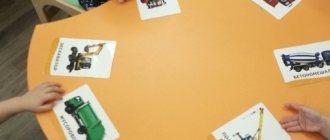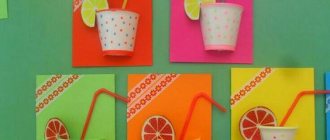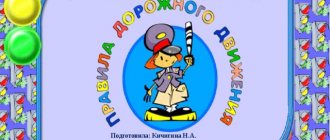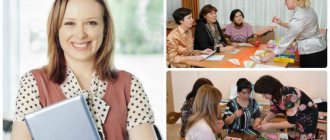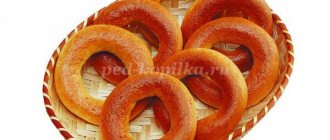Summary of educational activities for speech development with children of the junior group "Transport"
GCD in the senior group of preschool educational institutions.
Abstract Description of the material : this abstract may be useful for teachers of junior groups on the topic “Transport” Integration of educational areas: “Speech development”, “Cognitive development”, “Social and communicative development”, “Physical development”. Objectives: Social and communicative development:
- To develop in children self-control and the ability to listen to other children.
— Form a sense of discipline, responsibility, friendliness. — Develop communication skills. Cognitive development:
- To consolidate the concept of “transport”, the ability to classify “passenger transport”, “freight transport”.
— Continue to familiarize children with traffic signals and traffic rules. — Repeat the parts of the truck (cabin, body, steering wheel, pedals) and their purpose. - Fix the names of geometric shapes. - Develop intelligence and logical thinking. Speech development:
- Develop speech, logical thinking.
— Improve the sound culture of speech. — Intensify the use of prepositions in speech. — To develop the ability to use generalizing words in speech. Physical development:
- Preserve and strengthen the health of children, using health-saving technologies (finger exercises, outdoor games) - Develop coordination of movements, fine motor skills.
Material for the lesson .
Dunno doll, sets of pictures “Passenger transport”, “Freight transport”, d/game “Assemble a car” (car parts to collect on an easel), geometric shapes 1 square, 2 rectangles, 2 circles for each child. GCD move.
1. Dunno visiting the guys. Dunno invites children to guess riddles, find and show them in pictures. - The house is walking down the street, taking everyone to work. (Bus) - What kind of bird: doesn’t sing songs, doesn’t build nests, carries people and cargo. (Airplane) - Without acceleration, it takes off high, Reminds me of a Dragonfly, Takes off into flight Our Russian…. (Helicopter) - This horse doesn’t eat oats, Instead of legs there are two wheels. Sit on horseback and race on it, but steer better. (Bicycle) - Doesn’t fly, doesn’t buzz, the Beetle is running down the street. And two brilliant lights burn in the beetle’s eyes. (Machine) - He swam across the water, taking us with him. (Ship) - Green huts Attached to each other. One of them with a pipe takes everyone along with her. (Train) 2. Finger game “Transport” 1,2,3,4,5- Let’s call transport! Car, helicopter, tram, bus, plane. We clenched 5 fingers into a fist. 5 types of transport were named. 3. Speech game “Finish the sentence” - The train goes on the rails, and the bus goes ... (on the ground) - The tram is big, and the bicycle ... (small) - The plane flies across the sky, and the ship floats .... (by water) - The bus is traveling, and the plane.... (flies) - The car has 4 wheels, and the bicycle... (2) 4. Physical exercise “We’re going, we’re going...” (Children perform movements, accompanying them with words.) We’re going, we’re driving the car, Press the pedal. We turn the gas on and off. We look intently into the distance. The wipers clear away the drips. Right, left - clean! We are drivers anywhere! 5. D/game “Parts of a truck” (Children name the parts of a truck, lay them out on an easel. The truck is assembled.) 6. D/game “Traffic light” Children, together with Dunno, follow the traffic lights and perform the actions: red - stand , yellow - start the engines, green - drive. 7. Independent activity. Dunno invites children to assemble a truck from geometric shapes.
We recommend watching:
Summary of GCD in the senior group. A journey through Chukovsky's fairy tales. Notes on direct educational activities in the senior group for children with mental retardation. Notes on cognitive and research activities in the senior group. Notes on educational activities in the senior group on the topic “How to see the air.”
Similar articles:
Summary of a safety lesson in the senior group: Safety in nature
Lesson on basic safety in the senior group. Topic: Rules of conduct while walking
Life safety tasks for children 5-7 years old
Synopsis of an educational lesson in junior group II on the topic “Transport”
Program content:
1. Strengthen children’s knowledge about trucks, cars, and buses. Give the concept that everything is transport.
2. To consolidate knowledge about the rules of the road (they cross the street in special places, you only need to cross when the traffic light is green).
3. Develop attention and memory.
4. Develop self-control and the ability to listen to other children.
Materials for the lesson:
- Toys: trucks and cars of different colors and sizes, bus;
- Cars, trucks, buses (different colors) cut out of cardboard and cut into two parts;
- Street layout (houses, cars, traffic lights, little people, road signs);
- Flags of three colors (yellow, red, green);
- Traffic light layout;
- Steering wheels.
Individual work:
1 – consolidate in speech the words transport, pedestrian crossing, sidewalk, roadway.
2 – learn to clearly pronounce the words passenger, cabin, transport.
Progress of the lesson:
- Guys, look how many cars are in our garage? (A lot of cars.)
- What color are they? (Red, yellow, green, etc.)
– Do you like these cars? (Yes.)
- Alyosha, take the car you like. Tell me, what is she like? (Car.)
-What does the car have? Tell and show.
(The child names and shows the wheels, steering wheel, seat.)
-Who drives the car? (Driver.)
– What is the name of the place in the car where people sit? (Salon.)
(The words driver, salon are repeated by two children, choral answers.)
– Vika, take this car and tell us about it.
(The teacher offers a truck. The child names and shows the body, cabin, wheels, and their color.)
- Guys, tell me, who drives the car? (Driver.)
-Where is he sitting? (In the cockpit.)
– Why does the car have a body? (They carry cargo in it.)
– What kind of cargo? (Sand, bricks, boards, snow, etc.)
The teacher offers to tell the third child about the bus.
- What is this? (Bus.)
- What colour is he?
– What does the bus have? (Steering wheel, wheels, seats.)
– What is the name of the place on the bus where people sit? (Salon.)
The teacher addresses all children:
– Tell me, what are the names of the people who travel on the bus? (Passengers.)
– Who drives the bus? (Driver.)
- Well done boys. You spoke well about all the cars. How can you call them in one word? (Transport.)
(The words salon, passengers, driver, transport are repeated by two or three children, as well as in chorus.)
The teacher invites the children to sit at the tables.
– On your trays you have various cars (trucks, cars, buses) cut out of cardboard and cut into pieces. Your task: to assemble a car from parts.
Children's work:
At the end of the work, the teacher asks the children what kind of car they got, what color?
- Guys, tell me again, how can you call all the cars in one word? (Transport.)
- Now come and look here. This is a street layout. Tell me, what is the name of the part of the street where the cars go? (Roadway - choral and individual answers.)
(The teacher offers to show the other children the roadway.)
– What is the name of the narrow path near the roadway where people walk? (Sidewalk - two children repeat.)
(The teacher invites other children to show the sidewalk on the model.)
– Show me where to cross the road?
(Children show a pedestrian crossing.)
– What is the name of this striped path? (Zebra crossing, pedestrian crossing.)
(After individual answers, the children repeat the words sidewalk, pedestrian crossing all together.)
– Can children cross the road alone? (Not possible, only with parents, holding the hand of an adult.)
– What color of traffic light can you cross the road at? (On green.)
(The teacher shows the layout of the traffic light.)
- Guys, what is this? (Traffic light.)
– What do you think it is for? (So that cars don’t collide when driving; so that they don’t run into people, so that people cross the road safely).
– What do cars do when the traffic light is red? (Standing.)
- To yellow? (They are getting ready to go.)
- To green? (They go.)
Now we are going to play a game. You are car drivers. Take the steering wheels. I have flags in my hands - green, yellow, red. They represent the colors of the traffic lights. If I raise a red flag, you... (children add) - stand, yellow - turn on the engine, press the pedals, green - drive. Rule for everyone: drive without bumping into each other.
The game is played 2-3 times.
At the end of the game, the teacher invites the children to go to the garage where the toy cars are and play with them.
Summary of educational activities for speech development with children of the 2nd junior group “How transport helps us”
Summary of educational activities for speech development with children of the 2nd junior group
“How transport helps us”
Goal: Create a positive emotional mood in children; contribute to the formation of children's play motivation.
Tasks:
Teach children to distinguish and show the main parts of a car (cabin, body, wheels);
Develop speech, attention, general motor skills;
Activate children's vocabulary;
Enlarge your vocabulary;
Integration across educational areas.
“Cognitive development”
- Improve the ability to group transport into passenger and cargo;
— Teach children to construct sentences expressing a request, to correctly name objects in the “Avtolyubitel” store; — Improve counting within five; “Social and communicative development”
— Promote the establishment of positive contacts between children, provide mutual assistance;
— Form the basics of safe behavior in transport and on the road; — Encourage children for their ability to actively participate in a conversation and answer the teacher’s questions; "Speech development".
— Activate children’s vocabulary using words: transport, cargo, passenger, passenger, cabin, body, interior.
- Transform the verb using prefixes, practice using prepositions: on, by, with, under, for; — To train children in the ability to correctly name the endings of genitive plural nouns; - Coordinate speech with movements; "Physical development".
— Preserve and strengthen children’s health by using health-saving technologies (outdoor games);
— Improve the ability to catch and throw the ball, develop coordination and fine motor skills; “Artistic and aesthetic development.”
— Develop visual memory;
Progress of the lesson:
— Guys, how did you get to kindergarten today? (on foot, by bus, by trolleybus);
- Those who live next to the kindergarten came on foot, and those who live far from the kindergarten went in passenger transport (the teacher shows images of a bus, trolleybus, taxi, tram);
— What are the people who travel in passenger transport called? (passengers);
-Who can be the passenger? (boys, girls, uncles, aunts...);
— And by passenger transport, where can you get there? Where do you think people are going? (to work, home, school, market, theater...);
— Transport helps us get where we need to go;
— Guys, what do passengers do in passenger transport? (sitting, standing, looking out the window, talking....);
Let's play the game "One Many". (The teacher throws the ball to the child and says “One bus”; the child throws the ball back and answers “Many buses”).

